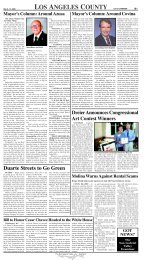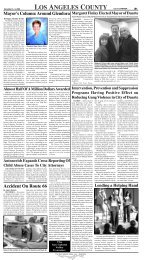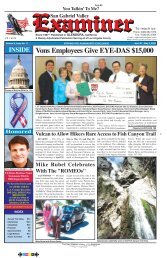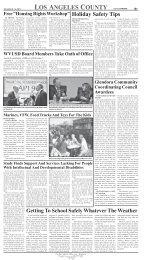B May 28 - June 3, 2009.pmd - San Gabriel Valley Examiner
B May 28 - June 3, 2009.pmd - San Gabriel Valley Examiner
B May 28 - June 3, 2009.pmd - San Gabriel Valley Examiner
Create successful ePaper yourself
Turn your PDF publications into a flip-book with our unique Google optimized e-Paper software.
B4 S.G.V. EXAMINER FINANCIAL/CONSUMER<br />
The Shape Of Things To Come<br />
Signs of improvement in the<br />
economy are everywhere. Business<br />
orders in aggregate are still<br />
falling, but airlines, luxury retailers,<br />
and business equipment<br />
manufactures have reported rising<br />
revenues in their first quarter<br />
results. The economic data<br />
also point to improvement, with<br />
an increase in real consumer<br />
spending in the first quarter, as<br />
well as improvement in most<br />
regional manufacturing surveys.<br />
Real GDP is still likely to fall in<br />
the quarter, but there is a very<br />
real possibility of positive GDP<br />
growth before year end. The<br />
real question on Wall Street's<br />
mind is, is it a sustainable recovery,<br />
or a dead-cat bounce?<br />
What we have seen since the<br />
recession began is an old-fashioned<br />
inventory management<br />
cycle. Most retailers track stock<br />
as it is rung up on their registers<br />
and only order when goods<br />
are almost depleted. Wholesalers<br />
and manufacturers do the<br />
same with even better precision.<br />
But all businesses must carry a<br />
little extra stock to allow for<br />
unexpected surges in sales and<br />
the time it takes for goods to<br />
move through the pipeline. As a<br />
result, in the event of a drop in<br />
sales, inventories will pile up.<br />
That is just what happened in<br />
the fourth quarter of last year.<br />
As a result, much of the weakness<br />
in this year's first half is<br />
coming from an inventory correction.<br />
Because a lot of what wholesalers<br />
and retailers do is based<br />
on pure speculation, there remains<br />
a viable risk that after inventories<br />
rebound, we could see<br />
a double-dip recession; especially<br />
if sales remain tentative.<br />
Since 1970, there are five cases<br />
of positive GDP growth, ranging<br />
from 0.9% to 3.6%, in the<br />
midst of recessions, after which<br />
GDP fell again by as much as<br />
6.2%. In other words, there<br />
were double-dips in five of<br />
seven post-war recessions.<br />
Looking further at history,<br />
the most impressive double-dip<br />
in the post-war era was not in<br />
any one recession, however. It<br />
In In A A Nutshell<br />
Nutshell<br />
What’s up in the Economy?<br />
KEN HERMAN<br />
Economic Analyst<br />
Glendora Councilman<br />
was in two. After the short but<br />
violent 1980 recession, GDP<br />
growth averaged nearly 8% in<br />
the first two full quarters of the<br />
recovery, strong enough to justify<br />
Wall Street calling the end<br />
of the recession. In fact, it was<br />
so vigorous, inflation quickly<br />
jumped to double digits, forcing<br />
the Federal Reserve to aggressively<br />
hike interest rates,<br />
throwing the economy into the<br />
prolonged recession of 1981-<br />
82.<br />
The most important lesson<br />
from the early Eighties was not<br />
that printing too much money<br />
inevitably leads to excessive inflation.<br />
Rather, it was that a Fed<br />
faced with excessive inflation as<br />
a result of printing too much<br />
money will throw the economy<br />
back into recession before it lets<br />
inflation get completely out of<br />
control.<br />
Anyone who thinks this lesson<br />
is lost on Ben Bernanke<br />
should re-read his confirmation<br />
testimony, when he explained<br />
why the Great Inflation of the<br />
Seventies stands on a par with<br />
the Great Depression of the<br />
Thirties at the top of the list of<br />
Federal Reserve policy blunders.<br />
Bernanke understands the<br />
damage high levels of inflation<br />
can do.<br />
So, what is the shape of<br />
things to come recognizing the<br />
complexity and risks in today's<br />
economic uncertainties? GDP<br />
growth is deeply negative now,<br />
but could rise as much as 3%<br />
at an annual rate in the fourth<br />
quarter thanks to the shift from<br />
the horrific inventory correction<br />
to a positive inventory accumu-<br />
lation.<br />
Consider the case of GM,<br />
which was producing cars for<br />
a 15 million-unit market in 2008<br />
and will transition to producing<br />
cars for a 10 million unit market<br />
at the end of this year. In<br />
the interim, they plan to shut<br />
down for almost two thirds of<br />
the third quarter. Even though<br />
GM will be producing at a significantly<br />
reduced rate in the<br />
fourth quarter compared with<br />
last year, its contribution to<br />
fourth quarter GDP will be significant<br />
because production will<br />
more than double between the<br />
third quarter and fourth quarter.<br />
Multiply this out across the<br />
economy and the impact will be<br />
dramatic.<br />
But are we talking a V-shaped<br />
bounce, or a W-shaped one?<br />
That depends on the shape of<br />
the credit cycle. The end of the<br />
inventory correction will give<br />
the economy a nice jump start,<br />
but it cannot carry the economy<br />
indefinitely. For that, we need<br />
consumer spending, or more<br />
specifically, consumer credit<br />
and income to finance consumer<br />
spending. Are we witnessing the<br />
beginning of a false start in the<br />
economy? Watch the consumer<br />
lending numbers through the<br />
second half and you will have<br />
the answer.<br />
A secondary risk for a<br />
double-dip recession in 2010 is<br />
there is so much stimulus in the<br />
system. Even if the Fed times it<br />
just right and reverses its rate<br />
cuts, shuts down its liquidity<br />
programs and starts to draw<br />
down bank reserves, it may find<br />
fiscal policy is still too stimulative.<br />
Congress, after all, is much<br />
better at spending than cutting<br />
back. If the economy gets too<br />
hot, Wall Street is betting on the<br />
Fed tightening the economy into<br />
a recession next year before it<br />
allows inflation to soar.<br />
SHOP GLENDORA FIRST<br />
- OUR MERCHANTS NEED<br />
US<br />
I welcome your questions and<br />
comments:<br />
kenherman46@hotmail.com<br />
The <strong>San</strong> <strong>Gabriel</strong> <strong>Valley</strong> <strong>Examiner</strong><br />
<strong>May</strong> <strong>28</strong> - <strong>June</strong> 3, 2009<br />
Consumer - Ask Julia<br />
I'm 55 years old. I have a<br />
Roth IRA with one company,<br />
two retirement accounts with<br />
previous employers, and a 401k<br />
with my current employer.<br />
Can I combine all these IRA's?<br />
Not quite. Your Roth IRAs are<br />
funded with after-tax dollars,<br />
with tax-deferred (potentially<br />
never again taxed) growth.<br />
Your retirement accounts and<br />
401k IRA accounts are funded<br />
with pre-tax dollars (tax-deferred<br />
plus tax-deferred<br />
growth). I'd recommend leaving<br />
the Roth IRAs separate because<br />
of Roth IRA rules. The<br />
retirement accounts probably<br />
could be combined without<br />
causing a taxable event. I can<br />
help you find an investment<br />
product that offers a bonus on<br />
your investment dollars (helping<br />
to make up for some of your<br />
recent losses), and which is<br />
suitable for your individual circumstances.<br />
Combining retirement<br />
accounts also helps to simplify<br />
life for your beneficiaries<br />
who might not even know about<br />
your scattered accounts.<br />
We're considering purchasing<br />
a foreclosed, bank-owned<br />
property. What advice can you<br />
offer?<br />
I can help you get started by<br />
working to get you pre-approved<br />
by a lender. Then, as a<br />
Realtor, I can help you find several<br />
properties of interest.<br />
(Some banks will only accept<br />
an offer submitted by a Realtor.)<br />
You might have to finance<br />
your purchase with the same<br />
bank that owns the property.<br />
Get an independent property<br />
inspection, and count the cost<br />
of repairs. Your offer should<br />
reflect your findings. Banks are<br />
taking anywhere from 2 weeks<br />
to 2 months to decide whether<br />
or not to accept an offer. With<br />
this in mind, there are properties<br />
which have already been<br />
through the bank's decision process,<br />
and which can close escrow<br />
much faster. Also, there<br />
are houses - not foreclosures,<br />
or bank-owned - which are<br />
priced right.<br />
Preservation Laws And Economic Vitality: Is<br />
Azusa Willing To Protect Its Own History?<br />
By Paul Naccachian<br />
<strong>May</strong> is the official month for<br />
national historical preservation.<br />
In the United States, the preservation<br />
movement emerged as<br />
a result of public concern to<br />
preserve resources associated<br />
with significant figures and<br />
events in American history predating<br />
the Civil War.<br />
As a result, Congress passed<br />
a series of important Acts, the<br />
most important of which, the<br />
National Register of Historic<br />
Places Act of 1966 (NHPA),<br />
established the National Register<br />
of Historic Places as a list<br />
of districts, sites, buildings,<br />
structures and objects significant<br />
in American history, architecture,<br />
archaeology and culture.<br />
States and localities follow<br />
similar standards as the<br />
Federal laws.<br />
In most states and localities,<br />
including Azusa, the period<br />
from 1950s through the 1970s,<br />
saw the worst in preservation<br />
history where 2 million Americans<br />
were displaced from their<br />
homes as a result of cities utilizing<br />
an instrument called "urban<br />
renewal" to destroy and cut<br />
through huge numbers of historic<br />
property across America.<br />
On a local level, continuing<br />
at this pace we will lose our<br />
most valued assets: the remaining<br />
historic homes and commercial<br />
sites.<br />
Although we have the Historical<br />
Commission, it does little to<br />
prevent or take citywide active<br />
measures to preserve. To be<br />
fair, with its limited powers<br />
serving as an advisory body, it<br />
has accomplished some goals in<br />
preserving some of the public<br />
buildings such as the Civic Auditorium<br />
and the Women's Club.<br />
Paul Naccachian<br />
It has also created a voluntary<br />
potential list of 142 historical<br />
properties in the mid 1990's that<br />
the City Council casually recognized<br />
but did not give the<br />
green light to take it to the next<br />
level. Currently, the list no<br />
longer exists. There is no formal<br />
record keeping requiring<br />
property owners to abide by any<br />
design guidelines. Thus, the historic<br />
buildings do not have any<br />
protection.<br />
At a minimum, the plastering<br />
of older homes and commercial<br />
building which otherwise would<br />
qualify as historic should stop.<br />
I am troubled to drive, or often<br />
walk, to the post office and look<br />
at the church across the street<br />
that recently burnt down. The<br />
rebuilt structure is made of a<br />
vinyl veneer façade with a plastered<br />
south wall of what use to<br />
be a wooden structure built at<br />
the early part of the turn of the<br />
century. Any reasonable person<br />
with an objective eye can look<br />
at this rebuilt structure and at<br />
best give it an F grade. It is a<br />
failure both on the administrative<br />
level and the property owners.<br />
Drive around Azusa and<br />
you will see similar instances of<br />
historical destruction.<br />
Aside from the nostalgic and<br />
aesthetic value to the community,<br />
preservation is also a means<br />
to maintain architectural design<br />
guidelines and stimulate economic<br />
activity. For example, the<br />
National Trust model examines<br />
preservation from an economic<br />
standpoint evaluating the real<br />
estate element, construction,<br />
and economic activity within a<br />
community. In short, the model<br />
quantifies preservation's economic<br />
contributions to the local<br />
economy.<br />
Based on the model, studies<br />
have shown that building rehabilitation<br />
outperforms new construction<br />
in creating economic<br />
activity, and that "dollar for dollar,<br />
historic preservation is one<br />
of the highest job-generating<br />
economic development options<br />
available." For example, one<br />
study concluded that in California<br />
$1 million of rehabilitation<br />
creates five more jobs than<br />
manufacturing $1 million worth<br />
of electronic equipment. These<br />
are not just temporary construction<br />
jobs, but also permanent<br />
jobs of various types, including<br />
continuing building repair<br />
and maintenance.<br />
One of the basic reasons that<br />
owners resort to plastering of<br />
homes is associated with cost.<br />
It is generally understood that a<br />
paint job on a craftsman home<br />
will last between 7 to 10 years<br />
compared to plastered stucco<br />
that will last close to 30 years.<br />
First, a cost associated with<br />
maintenance is part of our daily<br />
lives; whether routine oil<br />
changes or replacing an aging<br />
roof on a house. Second, there<br />
are various programs to offset<br />
costs associated with historical<br />
structures. The Mills Act, for<br />
example, allows for tax incentives<br />
to owners of historical<br />
buildings on their property<br />
taxes.<br />
The case for the preservation<br />
model can also be extended to<br />
a downtown revitalization effort<br />
with increased economic vitality.<br />
A combination of research<br />
on economics and historic<br />
preservation (Rypkema 2005)<br />
has concluded that "virtually<br />
every example of sustained success<br />
in downtown revitalization-regardless<br />
of the size of the<br />
city-has included historic preservation<br />
as a key component of<br />
the strategy."<br />
Once again, these are not<br />
theoretical explanations, but<br />
Julia Yoder<br />
How do I know when to get<br />
out of the stock market?<br />
A little more than a year ago,<br />
I answered this question.<br />
Those who took action did not<br />
lose a penny in the investments<br />
I advised. If you can afford to<br />
lose money, then invest in the<br />
stock market, or go play the<br />
slots. If you cannot afford to<br />
lose your money, then you need<br />
to invest in products that guarantee<br />
you cannot lose your<br />
money. There are such products,<br />
but there are variables to<br />
consider here, too. Some give<br />
you a bonus on your investment<br />
dollars. Some are taxable, taxdeferred,<br />
or tax-free. Some<br />
give you more choices, more<br />
liquidity, and/or a guaranteed<br />
rate even during the payout<br />
years. Think of "allocation" in<br />
the broader sense: high risk,<br />
medium risk, low risk, and no<br />
risk. Depending on your specific<br />
situation, determine the<br />
percentage of your investment<br />
dollars you should wisely invest<br />
in each "risk" category. Above<br />
all, the worst thing you can do<br />
is nothing. Don't allow the uncertainty<br />
paralyze you. Think<br />
about, analyze, decide, and take<br />
action to make any necessary<br />
changes.<br />
My elderly parents thought<br />
they had saved enough for an<br />
active, fun-filled retirement<br />
when added to their Social Security<br />
benefits and a pension<br />
income. However, the cost of<br />
everything has gone up more<br />
than they expected, so now<br />
they have to watch and worry<br />
about every penny. They've<br />
found ways to have fun, but<br />
on a much scaled-down level.<br />
Now, dad has been diagnosed<br />
with Alzheimer's and mom<br />
doesn't know how long she'll<br />
be able to take care of him. My<br />
husband and I are able to help,<br />
but we don't want to end up in<br />
the same situation when we<br />
retire. Help!<br />
Thank you - many readers<br />
rather actual measured successes<br />
that have been reported<br />
based on years of study on human<br />
behavior, social sciences,<br />
and economics.<br />
While we culturally celebrate<br />
through our innovations, take<br />
pride in building bigger and better,<br />
that does not stop us from<br />
being more preservation minded<br />
especially in smaller, local communities.<br />
The real question is:<br />
whether the property owner of<br />
a historic building is committed<br />
to understanding the preserva-<br />
can learn from your situation.<br />
There's a good possibility that<br />
help is available for your parents.<br />
This help could be uncovered<br />
by taking a good look<br />
at their entire financial picture:<br />
assets, liabilities, insurances,<br />
and legacy plans. To figure how<br />
much you and your husband<br />
might need to be saving in order<br />
to have the retirement<br />
lifestyle you desire, go to my<br />
Wise Investor's Network<br />
website (see below), and use<br />
the calculator(s) you find there.<br />
Inflation (the overall increase in<br />
the prices of goods and services<br />
over time) and taxes are two<br />
major dangers when it comes<br />
to protecting your financial portfolio.<br />
Depending on age, when<br />
you plan to retire, and your risk<br />
tolerance, (as well as other personal<br />
circumstances), there are<br />
steps you should be taking to<br />
offset the effect of inflation on<br />
your retirement cash flow. If<br />
your retirement savings is taxdeferred,<br />
you should plan on the<br />
effect of having to pay taxes as<br />
you draw your income. Planning<br />
ahead with long-term care<br />
insurance is very important,<br />
too, as none of us can predict<br />
our level of health. Family<br />
caregivers often wear their<br />
health down while caring for the<br />
more ill relative. Paying out-ofpocket<br />
for long-term care can<br />
deplete savings rapidly.<br />
Do millionaires use Independent<br />
financial professionals?<br />
According to a Fidelity investments<br />
study resulting from<br />
a survey of more than 1,000<br />
households with $1 million in<br />
investment assets, more millionaires<br />
are using independent advisors<br />
than in previous years.<br />
Get your FREE, life insurance<br />
policy review, beneficiary<br />
review, and/or tax-return<br />
review. Set up your appointment<br />
today! Just call or<br />
email.<br />
Got a question? Ask Julia<br />
by email or phone.<br />
Julia Yoder is a licensed Servicing<br />
Agent for individual,<br />
family, and senior finances and<br />
insurance, a licensed Realtor, a<br />
Sr. Loan Officer, and Notary.<br />
www.WiseInvestorsNetwork.com<br />
and www.YoderKnows.com 1-<br />
877-802-8569 or (626) 625-<br />
5221, or juliayoder<br />
@WiseInvestorsNetwork.com<br />
(CA Insurance Lic.#0C83859)<br />
Member of the National Ethics<br />
Bureau<br />
tion value to a community?<br />
Preservation of our historic<br />
resources is an important starting<br />
point in any given community.<br />
Preservation efforts tell the<br />
story as to where we came<br />
from and what makes our community<br />
distinct from neighboring<br />
communities. Remember,<br />
preservation is economic<br />
growth, increased property<br />
value, and ultimately a pathway<br />
to a healthy dynamic community.
















